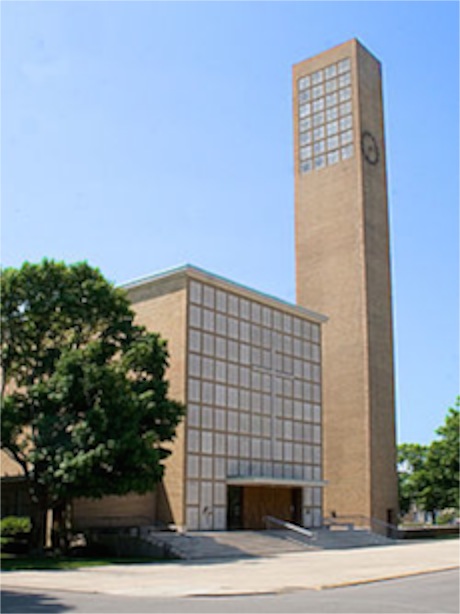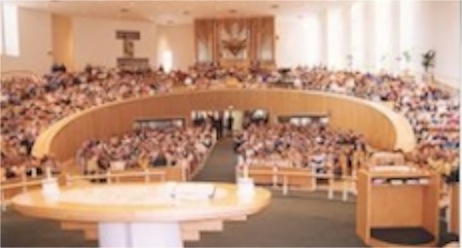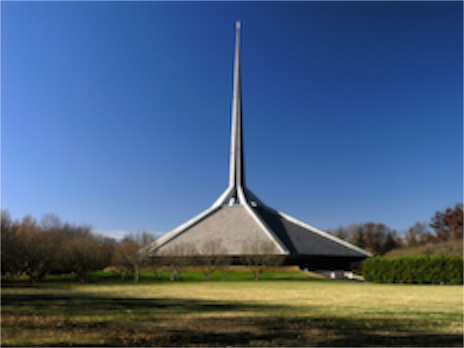Columbus, Indiana
28/10/12 05:29
Columbus, Indiana is a remarkable small city. A group of us made a visit to the city in 1975 or 1976 as a part of a seminary class in corporate ethics and responsibility. Columbus is the headquarters of Cummins, Inc., a manufacturer of industrial diesel engines. Cummins is the largest employer in the city of about 44,000. We toured the Cummins plant and it is an impressive manufacturing facility. One of the keys to quality control in the manufacturing process is the intense loyalty of the employees. Everyone we me believe that they were a part of a great company that makes great engines. There was a lot of personal pride in the company and its products.
There are many other notable features about Columbus, but one of the things I remember is the incredible architecture. Shortly after the Second World War, Cummins and others began to invest in architecture for the community. The company paid for local non-profits to hire world-famous architects to design their buildings.
 First Christian Church (Disciples of Christ) was designed by Eliel Saarinen in 1942. It is one of the first buildings in America designed in what has become to known as the modern school of architecture. The church features a 160-foot tall tower, a sunken terrace and a sanctuary that seats 900.
First Christian Church (Disciples of Christ) was designed by Eliel Saarinen in 1942. It is one of the first buildings in America designed in what has become to known as the modern school of architecture. The church features a 160-foot tall tower, a sunken terrace and a sanctuary that seats 900.
First Baptist Church was completed in 1965 and was designed by Harry Weese. The building is designed in five distinct sections: narthex, sanctuary, office wing, fellowship hall and chapel. All of the buildings are constructed around a courtyard. There are classrooms in the office wing. The sanctuary is one of the first windowless sanctuaries I had ever seen. It is a simple A-frame and it does have light from skylights, but all of the interior lighting is precisely controlled.
 St. Peter’s Lutheran Church (Missouri Synod) is a multi-story structure dominated by a tall spire. The sanctuary is in a semi round, with an altar and pulpit on one side and the congregation in a half-circle around the chancel area. It has tall clear windows that admit a lot of indirect light to the room. The contrast of the white interior with the darker wood interior of the Baptist Church is striking.
St. Peter’s Lutheran Church (Missouri Synod) is a multi-story structure dominated by a tall spire. The sanctuary is in a semi round, with an altar and pulpit on one side and the congregation in a half-circle around the chancel area. It has tall clear windows that admit a lot of indirect light to the room. The contrast of the white interior with the darker wood interior of the Baptist Church is striking.
 But the most dramatic church in Columbus, in my opinion, is the striking North Christian Church. It was designed by Eero Saarinen, the more-famous son of the designer of First Christian Church. The church was completed in 1964. The church is a hexagon with a 192-foot central spire. The sanctuary is at the middle of the building, with the communion table in the center of the room. An oculus admits light into the room below the spire. Rows of pews surround the communion table in a hexagon. Classrooms, kitchen and fellowship hall are on a lower level. The architecture reflects that congregation’s belief that worship is the center of their life together.
But the most dramatic church in Columbus, in my opinion, is the striking North Christian Church. It was designed by Eero Saarinen, the more-famous son of the designer of First Christian Church. The church was completed in 1964. The church is a hexagon with a 192-foot central spire. The sanctuary is at the middle of the building, with the communion table in the center of the room. An oculus admits light into the room below the spire. Rows of pews surround the communion table in a hexagon. Classrooms, kitchen and fellowship hall are on a lower level. The architecture reflects that congregation’s belief that worship is the center of their life together.
Our tour, a decade after the big building boom in the city, included a lot of other notable buildings. The Mabel McDowell School was the second building in town to have its architecture fee funded by the Cummins Engine Foundation. It opened in 1960 and was designed by John Carl Warnecke. It features a library with all of the furniture molded into the floor and walls, crawling tubes to connect various areas and lots of bright colors and natural light.
A lot of other public buildings benefited from the generosity of the Cummins Engine Foundation and hired top architects to design their structures. There is a library designed by I.M. Pei, a High School by Romaldo Giurgola, a Fire Station by Robert Venturi and a Myron Goldsmith newspaper office. The city also sports some significant public art including a fountain in front of the courthouse center.
At the time of our visit, I wondered what it might be like to live in such a place. Because our visit included an elementary school that was a striking contrast to any of the schools I had attended, I wondered what it might be like to be a child growing up in that community. Would being surrounded by such significant architecture make one more aware of and sensitive to art? Would one be more creative because of the surroundings? Would children growing up in such a safe and secure place be more likely to contribute to their state and nation? All of those things seem like possibilities.
There have been a few notable sports figures who grew up in Columbus. Basketball player and shoe designer Chuck Taylor grew up there. Race car driver Tony Stewart hailed from Columbus as does NFL player Blair Kiel. Chairman and founder of Sun Microsystems, Scott McNealy grew up in Columbus. So did Mr. Universe Bob Paris who is now a public speaker and best-selling author. The host of MythBusters, Jamie Hyneman grew up in Columbus. Fans of comic strips might recognize Bruce Tinsley, creator of the strip Mallard Fillmore. He is a product of Columbus, Indiana and its schools.
So Columbus does have its notables, but probably not more than other similar-sized cities. There is no evidence that having a choice of several very dramatic and powerfully-designed worship spaces has made the people of Columbus any more religious or more committed to living Christian values than those who worship in more modest surroundings. The effects of great art and great architecture are difficult to measure. Obviously the members of the Cummins Engine Foundation believed that such an investment in the community was a wise choice. It does demonstrate their faith in community and in the power of art to transform lives.
I wonder if people who grow up and live in Columbus are somehow disappointed with the rest of the world. Most of our towns have one or two notable buildings and lot of buildings that are copies of things built elsewhere or are primarily functional with little attention to art. A few of our sanctuaries are as inspiring and dramatic as those in Columbus. I know I am grateful to work and worship in a stunning building designed by Harold Spitznagel. He is probably most famous for Jehovah Lutheran Church in St. Paul, but I prefer our building over all of his other designs.
It is hard to say what the impact of all of the glorious buildings of Columbus, Indiana is on its residents, but it is a wonderful city to visit. We are affected by our surroundings. And there may yet be more to come from that city.
There are many other notable features about Columbus, but one of the things I remember is the incredible architecture. Shortly after the Second World War, Cummins and others began to invest in architecture for the community. The company paid for local non-profits to hire world-famous architects to design their buildings.
 First Christian Church (Disciples of Christ) was designed by Eliel Saarinen in 1942. It is one of the first buildings in America designed in what has become to known as the modern school of architecture. The church features a 160-foot tall tower, a sunken terrace and a sanctuary that seats 900.
First Christian Church (Disciples of Christ) was designed by Eliel Saarinen in 1942. It is one of the first buildings in America designed in what has become to known as the modern school of architecture. The church features a 160-foot tall tower, a sunken terrace and a sanctuary that seats 900.First Baptist Church was completed in 1965 and was designed by Harry Weese. The building is designed in five distinct sections: narthex, sanctuary, office wing, fellowship hall and chapel. All of the buildings are constructed around a courtyard. There are classrooms in the office wing. The sanctuary is one of the first windowless sanctuaries I had ever seen. It is a simple A-frame and it does have light from skylights, but all of the interior lighting is precisely controlled.


Our tour, a decade after the big building boom in the city, included a lot of other notable buildings. The Mabel McDowell School was the second building in town to have its architecture fee funded by the Cummins Engine Foundation. It opened in 1960 and was designed by John Carl Warnecke. It features a library with all of the furniture molded into the floor and walls, crawling tubes to connect various areas and lots of bright colors and natural light.
A lot of other public buildings benefited from the generosity of the Cummins Engine Foundation and hired top architects to design their structures. There is a library designed by I.M. Pei, a High School by Romaldo Giurgola, a Fire Station by Robert Venturi and a Myron Goldsmith newspaper office. The city also sports some significant public art including a fountain in front of the courthouse center.
At the time of our visit, I wondered what it might be like to live in such a place. Because our visit included an elementary school that was a striking contrast to any of the schools I had attended, I wondered what it might be like to be a child growing up in that community. Would being surrounded by such significant architecture make one more aware of and sensitive to art? Would one be more creative because of the surroundings? Would children growing up in such a safe and secure place be more likely to contribute to their state and nation? All of those things seem like possibilities.
There have been a few notable sports figures who grew up in Columbus. Basketball player and shoe designer Chuck Taylor grew up there. Race car driver Tony Stewart hailed from Columbus as does NFL player Blair Kiel. Chairman and founder of Sun Microsystems, Scott McNealy grew up in Columbus. So did Mr. Universe Bob Paris who is now a public speaker and best-selling author. The host of MythBusters, Jamie Hyneman grew up in Columbus. Fans of comic strips might recognize Bruce Tinsley, creator of the strip Mallard Fillmore. He is a product of Columbus, Indiana and its schools.
So Columbus does have its notables, but probably not more than other similar-sized cities. There is no evidence that having a choice of several very dramatic and powerfully-designed worship spaces has made the people of Columbus any more religious or more committed to living Christian values than those who worship in more modest surroundings. The effects of great art and great architecture are difficult to measure. Obviously the members of the Cummins Engine Foundation believed that such an investment in the community was a wise choice. It does demonstrate their faith in community and in the power of art to transform lives.
I wonder if people who grow up and live in Columbus are somehow disappointed with the rest of the world. Most of our towns have one or two notable buildings and lot of buildings that are copies of things built elsewhere or are primarily functional with little attention to art. A few of our sanctuaries are as inspiring and dramatic as those in Columbus. I know I am grateful to work and worship in a stunning building designed by Harold Spitznagel. He is probably most famous for Jehovah Lutheran Church in St. Paul, but I prefer our building over all of his other designs.
It is hard to say what the impact of all of the glorious buildings of Columbus, Indiana is on its residents, but it is a wonderful city to visit. We are affected by our surroundings. And there may yet be more to come from that city.